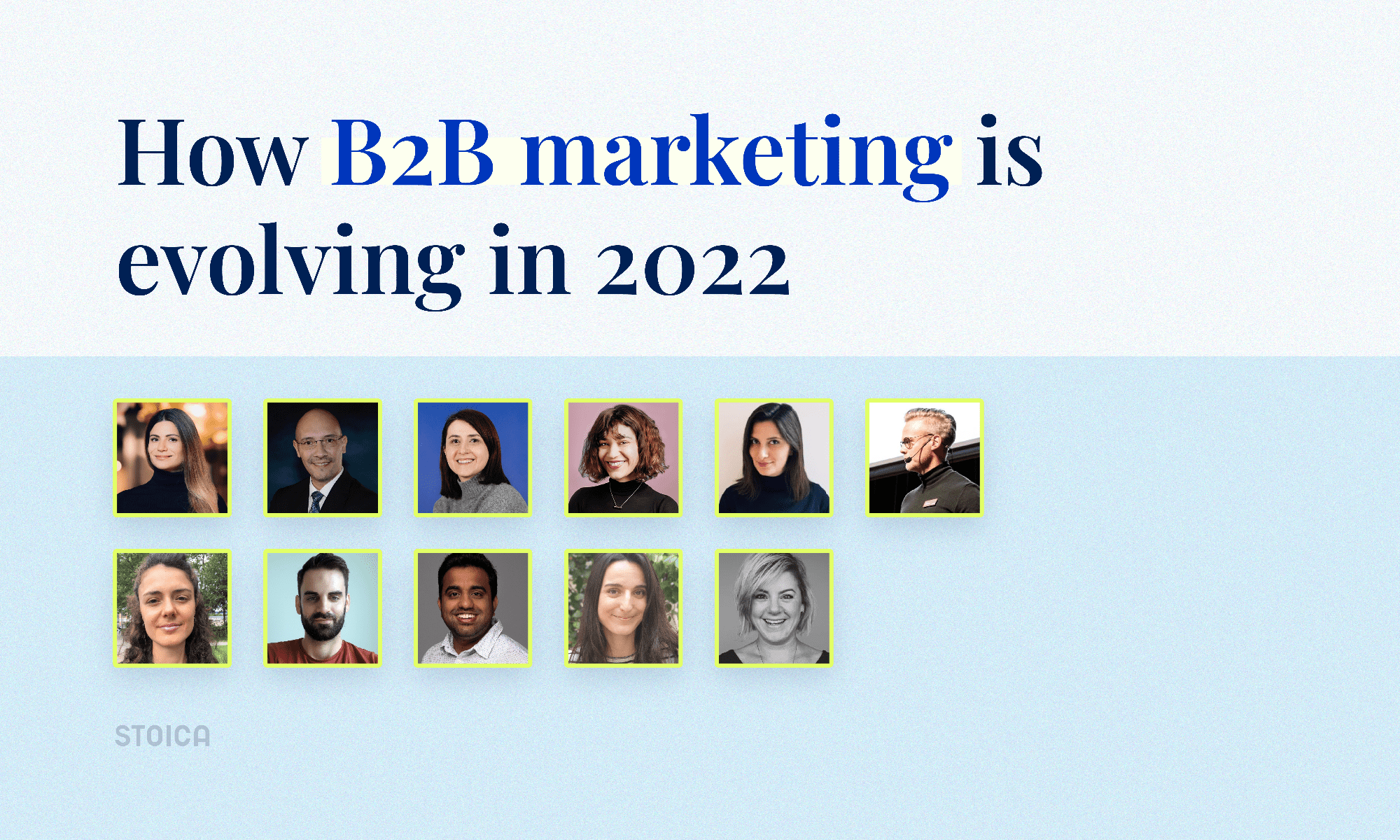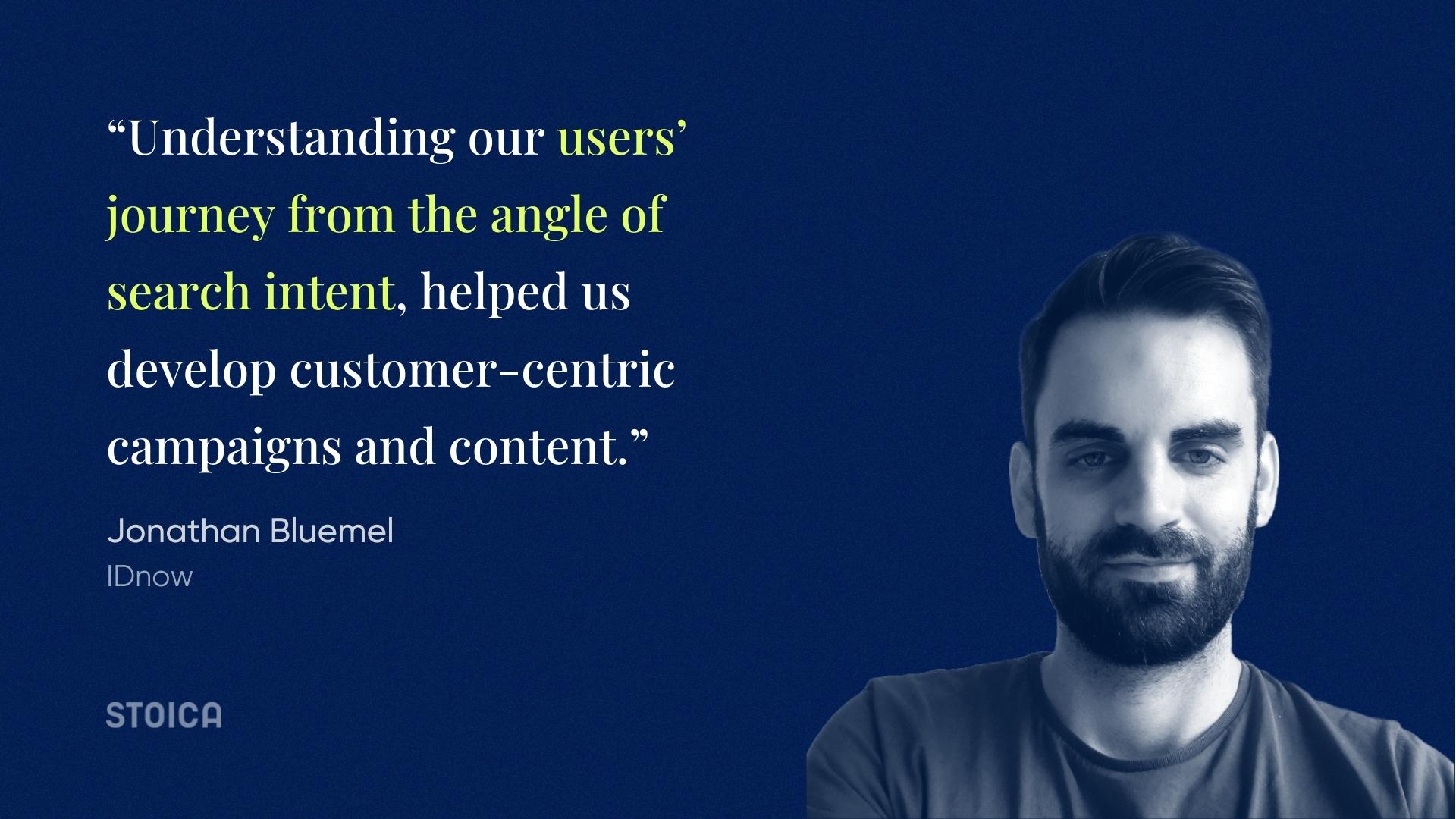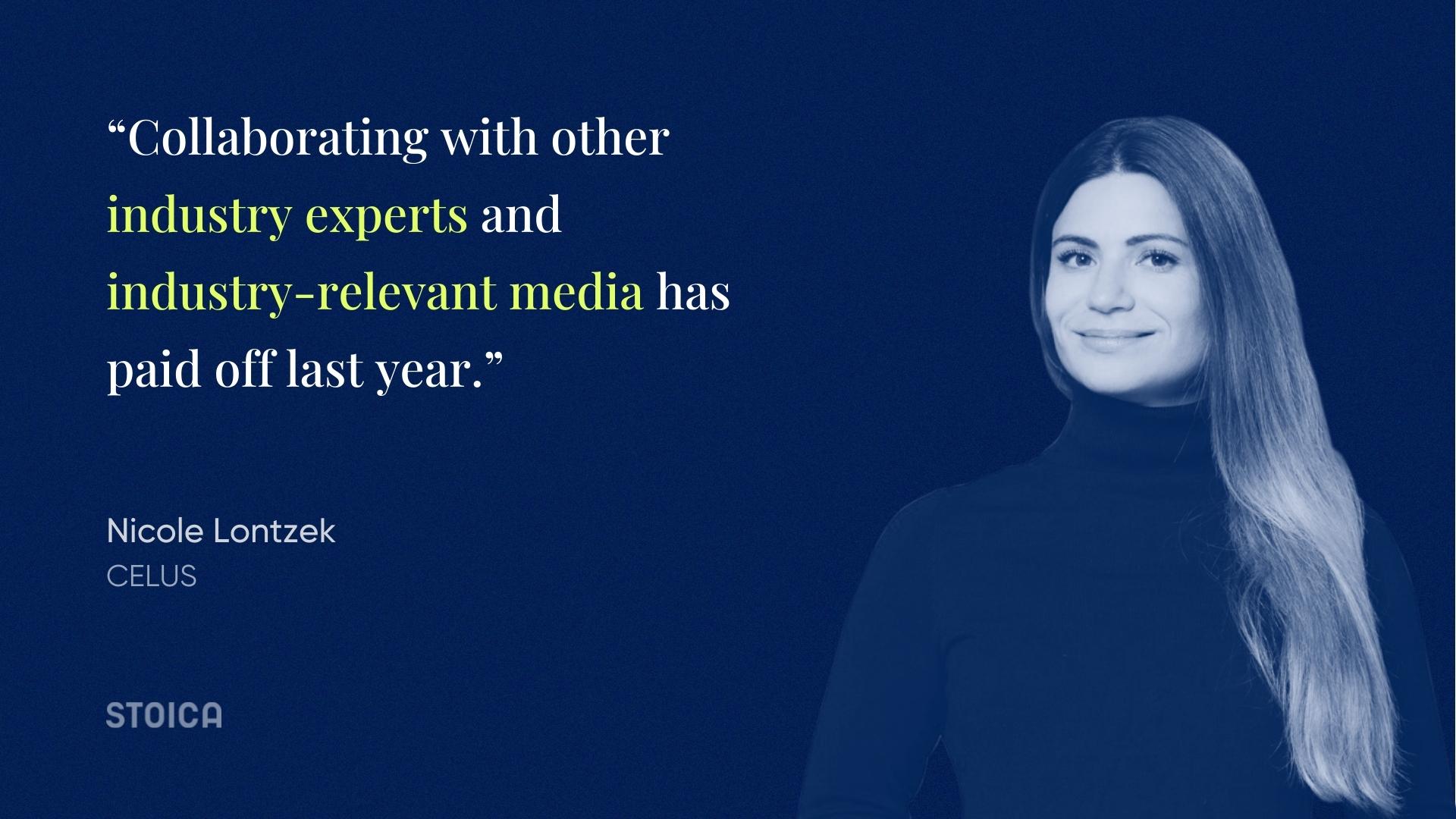Connecting with top marketing experts in your industry and learning how they approach their marketing strategy is an underused exercise.
You can go beyond generic recommendations you can find elsewhere and understand the thinking behind the strategy, and take those insights to improve your own approach to marketing.
Back in 2020, we launched a study together with 12 marketing experts in leading tech companies in Romania, trying to uncover how they were adapting their marketing in the face of rapid change.
In 2021, we created a second edition of the study, this time together with six marketing experts in the most dynamic tech companies across Belgium.
We are continuing this exercise in 2022, trying to make sense of what tactics and channels to focus on, and most importantly, how seasoned marketing professionals approach their marketing strategy in 2022
You’ll learn how our contributors leverage content beyond the inbound playbook, how personal branding becomes just as important as the company’s brand, how to leverage collaborations with industry experts and influencers to grow your brand recognition and build trust.
Special thanks
We would like to thank our contributors for sharing their insights and ideas in this eBook.
- Nicole Lontzek, Head of Marketing, CELUS
- Daniel Ionescu, Marketing Director, DRUID
- Andreea Serb, Global Content Manager, Channable
- Anna-Theresia Bohn, Team Lead Content Marketing B2B, Babbel
- Adam Holmgren, Head of Demand Generation, GetAccept | Host of the Demand Generation Movement Podcast
- Sara Lattanzio, B2B marketing strategist & content creator | Sr. Marketing Manager, Adnovum
- Alexandra Mogin, Marketing Manager, TenForce
- Jonathan Bluemel, Senior Content & SEO Manager, IDnow
- Aswin Gautham, Digital Marketing & Automation Manager, Movella
- Marilyne Dupuy, Head of Marketing, PickYourSkills
- Anne Smink, Head of Brand & Content Marketing, Recruitee
Read the entire article or skip to any chapter:
- Looking back: what worked well in 2021 and what didn’t?
- Looking forward: what are B2B marketers focusing on in 2022?
- Recommendations for 2022
Don’t have time to read now? Download and read later.
Looking back: what worked well in 2021?
#1 Content as a powerful way to reach your clients
Content is one of the most important marketing assets for a B2B brand and we would even go on a limb and say that in 2021 it was the only way to reach potential clients effectively.
An effective content strategy implies educating your potential clients (what problems you solve, help them diagnose those problems, and compare alternative solutions), inspiring (thought leadership and deep insights derived from your unique experience, telling your company’s story), and entertaining (interesting ideas from relevant experts in your field, building a community to facilitate knowledge sharing).
“The tactics that worked best for us in 2021 was launching high value, actionable content: webinars, workshops with small groups of people, checklists, templates, or eBooks.” – Marilyne Dupuy, PickYourSkills
“We focused on getting the right message to the right person, at the right time. We’ve spent time understanding each of our different personas and their specific challenges, creating relevant content to address them. Industry-specific content delivered to a narrower audience has rendered our offer more relevant and we managed to unlock more opportunities.” – Anna-Theresia Bohn, Babbel
However, merely creating content and distributing it was not enough anymore, so how did the marketing experts we consulted manage to make their content stand out?
Focus on video, and short-form video in particular
Video consumption has been growing and people are watching more videos than ever before: Wyzowl’s Video Marketing Survey shows that we now consume an average of over 2.5 hours per day, almost double than in 2018.
Not only is video popular but it’s also very effective in terms of attracting new business. In a recent HubSpot study, 76% of surveyed marketers that use video, call it their most effective content format. And 27% say it’s the content format that yields the biggest ROI.
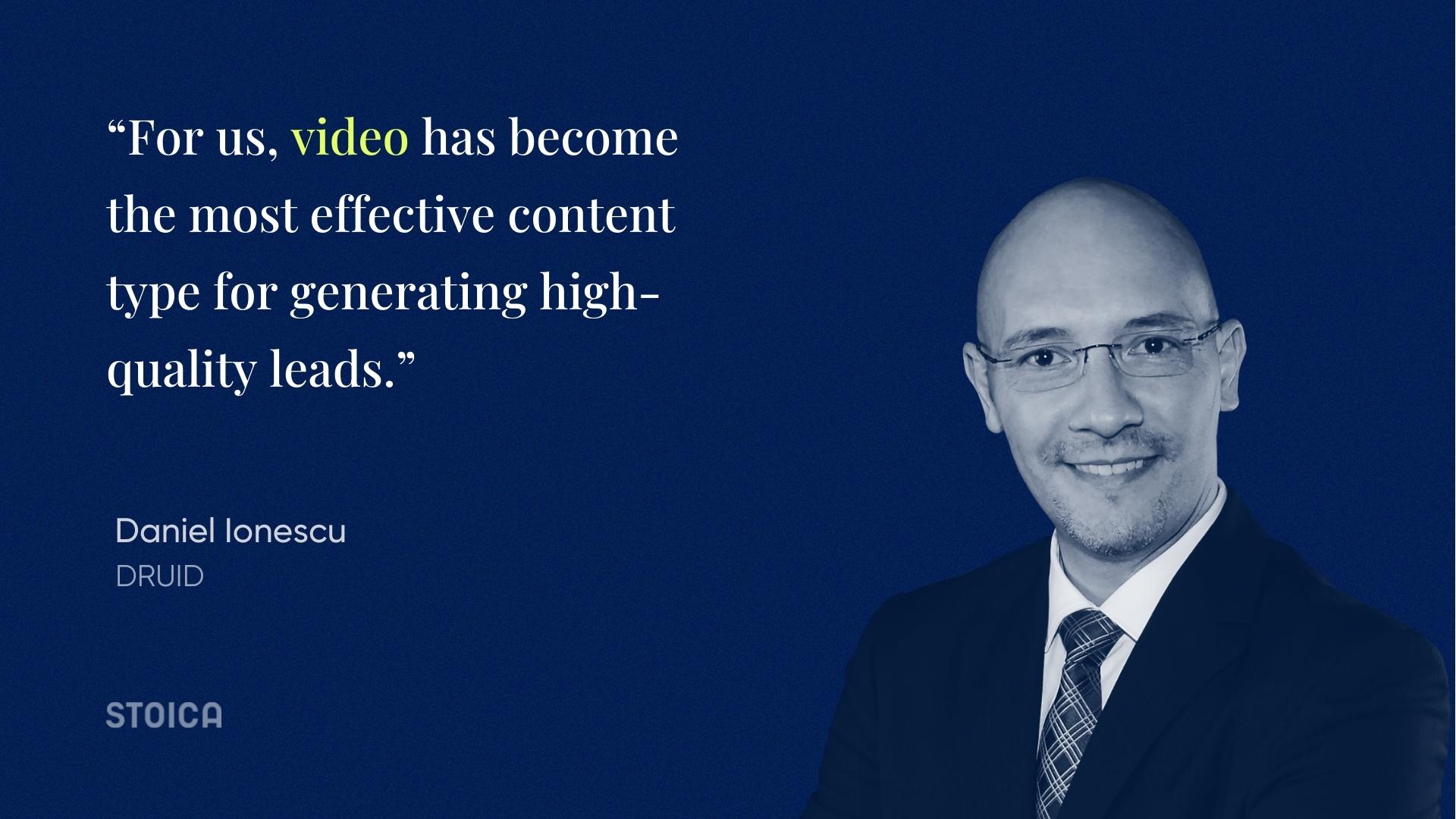
“For us, video has become the most effective content type for generating high-quality leads. I strongly recommend creating short-form video content, that can be used across multiple channels and targeted at different stages in the buyer’s journey.” – Daniel Ionescu, DRUID
But what makes video so attractive? For companies, it’s a great opportunity to show their “personality” and become more than a faceless organization. Through video, you can create an emotional connection with your audience.
Plus, video makes it easier for marketers to explain complex products or services and showcase how they work in real business scenarios.
“Last year we focused on explaining our product to our audience and answering their most pressing questions right away. Producing video content (including tutorials) for this purpose proved to be very successful: potential clients could gather information at their convenience before they got in touch with a Sales Representative.” – Nicole Lontzek, CELUS

Wyzowl data confirms the power of video in making a buying decision: 78% of people say they’ve been convinced to buy or download a piece of software or app by watching a video.
Take the example of Lemlist, they’re a start-up with a growing YouTube channel, using it to teach you how to do outbound emailing right and how to use their tool at the same time.
Sara Lattanzio also experienced the power of video in B2B, explaining that being human and focusing on conveying valuable information wins over perfectly produced videos.
“I noticed a radical difference between simple videos for LinkedIn, featuring leadership and team members, that performed significantly better in terms of engagement and traffic than any other more ‘polished’ campaign. It is evident that in B2B people want people and good content over high-end production.” – Sara Lattanzio, B2B marketing strategist & content creator
Building content for humans, not for search algorithms
Producing highly optimized content for SEO was no longer a winning bet in 2021. But rather understanding the intent behind keywords and search queries, and adding a layer of storytelling and useful information, as Andreea Serb explains.
“Matching keywords to our audience’s search intent is the fine line between ranking for a topic that no one bothers to engage with or really offering something of value that real people look for. It’s a balancing act to create optimized content and frame it in a way that offers a layer of storytelling, information, and entertainment.” – Andreea Serb, Channable
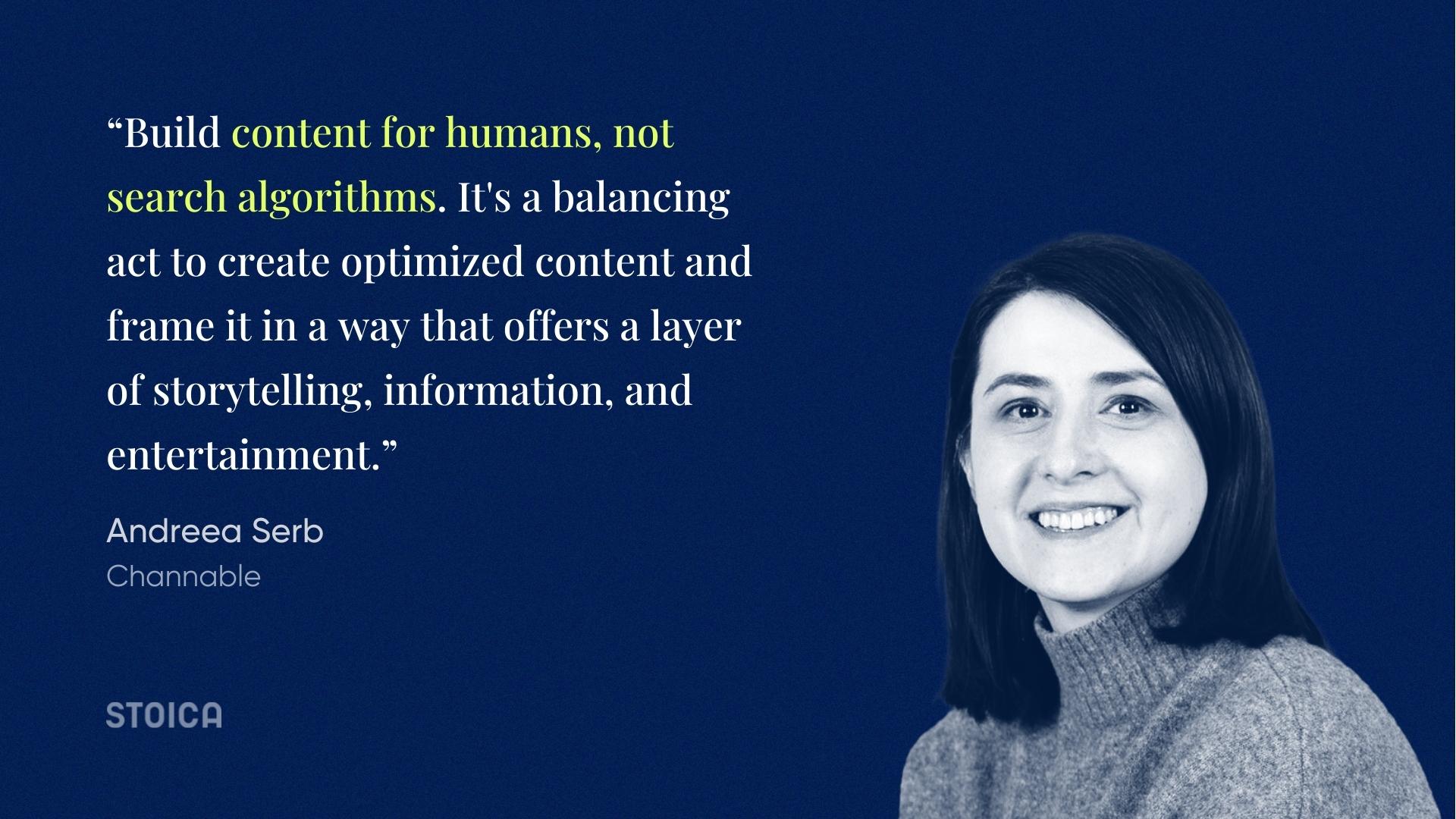
Jonathan Bluemel also stresses the importance of looking at your user’s journey from the angle of intent and creating content that matches that intent.
“Understanding our users’ journey from the angle of search intent and awareness stages, a concept also developed by MOZ and the likes, helped us develop customer-centric campaigns and content”. – Jonathan Bluemel, IDnow
Build trust with thought leadership content
For B2B companies, establishing authority is key to getting noticed by the right buyers and building trust. It helps you drive awareness about your company and positions your solution as a viable option.
However, creating thought leadership content goes beyond just having an opinion. Thought leadership content has to be rooted in your unique perspective, and it has to be backed by experience, data, arguments. Something few companies manage to get right.
Andreea Serb details her approach to creating thought leadership content.
“Thought leadership is combining original thoughts and ideas with key experts who have a unique set of knowledge and first-hand experience that will help your audience look at something from a new angle. Identifying key contributors from my team and the industry who helped us produce such content proved to be the kind of content people like to engage with.” – Andreea Serb, Channable
Using internal data to create unique content
One last idea of how our contributors managed to create outstanding content? Mining through their internal data to discover unique insights and pack them into reports or guides.
Andreea Serb explains
“Packaging original data into reports and guides not only gives you an edge from an editorial perspective but also positions you as a unique authority in the space and the go-to brand to look for when you need a certain type of industry-related information.” – Andreea Serb, Channable
#2 Focus on brand, both company’s brand & key employees’
Brand drives demand but it can easily be overlooked because the effects of branding are not easily quantified and tracked.
However, our contributors talked about investing in their company’s brand awareness as well as key employees’ brands as a winning approach for them in 2021.
Personal branding got a lot of attention and traction in 2021 and with good reason: key employees can do a great job at connecting and interacting with potential clients or partners and conveying your brand story. They become your brand ambassadors.
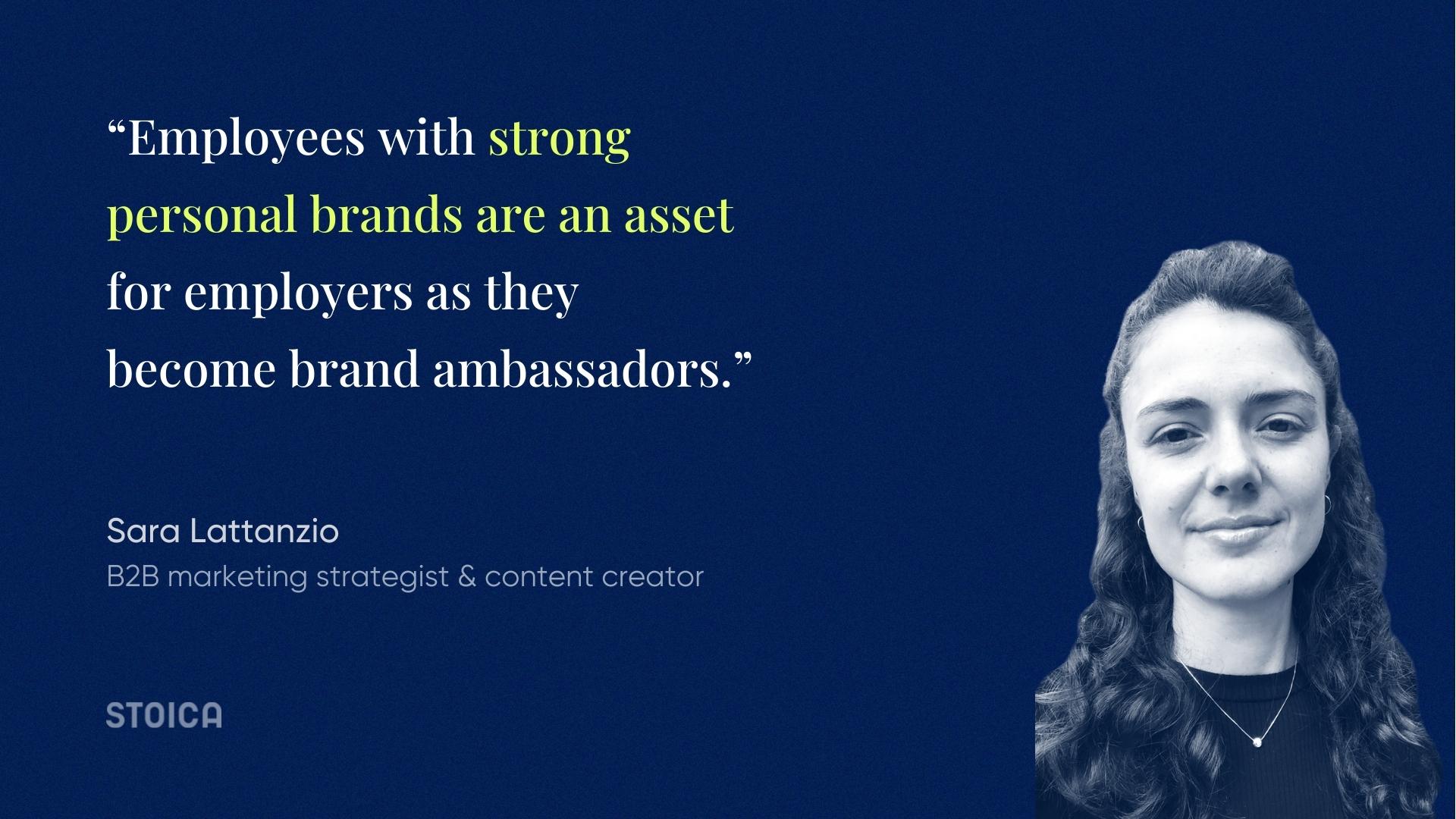
“I grew my Linkedin profile to over 6,000 followers in 7 months. Employees with strong personal brands are an asset for employers as they become brand ambassadors. I joined several podcasts and shared results and learnings from our marketing initiatives. ” – Sara Lattanzio, B2B marketing strategist & content creator
“Some of the best performing tactics for us in 2021 were paid advertising campaigns focused on brand awareness, and amplifying the organic content of our co-workers on LinkedIn.” – Adam Holmgren, GetAccept
“In the past year we managed to increase our brand awareness through podcasting: our German HR Podcast “Working Language” launched and is ranking on Spotify in a top position for our relevant keywords.” – Anna-Theresia Bohn, Babbel
#3 Get the right people to talk about you
Establishing your company‘s authority is not an endeavor you can conduct on your own, you need trusted industry journalists and influencers to vouch for your company.
Daniel Ionescu shares his experience at DRUID.
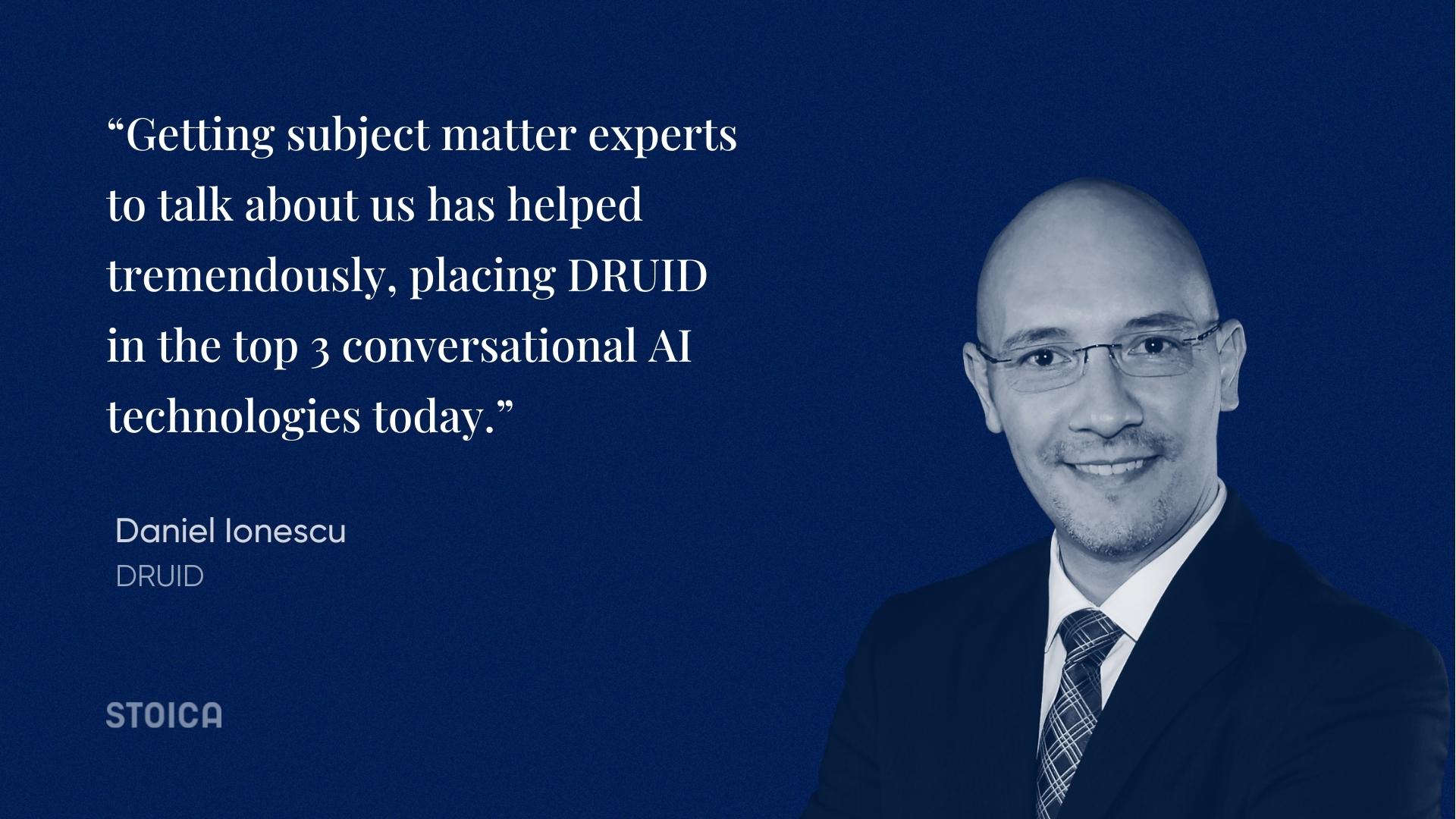
“2021 was an inflection point in DRUID’s global brand awareness. To quickly penetrate international markets, especially mature ones, state-of-the-art technology, powerful partners, or talented marketers are not enough. Getting subject matter experts and well recognized tech-trends predictors such as Gartner, Forrester, or IDC to talk about us has helped tremendously, placing DRUID in the top 3 conversational AI technologies today.” – Daniel Ionescu, DRUID
Nicole Lontzek adds “Collaborating with other industry experts and industry-relevant media has paid off last year. I would say it´s a combination of classic public relations and content aggregation with other companies.”
#4 ABM to reach and engage specific target accounts
Focusing the company’s resources towards engaging with a selected group of companies was another winning approach in 2021 as explained by some of the marketing experts we consulted.
“Strategic Account Based Marketing (targeting a select list of target accounts with tailored marketing and sales support) helped us focus our resources and have a better view of the marketing & business development impact on revenue.” – Alexandra Mogin, TenForce
There is no playbook for doing ABM and working against the rules sometimes pays off, as Marilyne Dupuy shares.
“Our second most performing actions was what we call “phygital”. We sent our most qualified prospects a postcard in the middle of summer, when business is usually low, that included a QR code to our website. 78% of the recipients checked our website during summer, and a lot of them even booked a demo!” – Marilyne Dupuy, PickYourSkills
#5 Strategy alignment and deep understanding of the customer’s journey
All the tactics mentioned by our contributors cannot work in isolation, but only if they are rooted in your clients’ challenges, motivations, and buying journey.
And for that, you need to study and know your ideal clients like the back of your hand and align the different marketing teams or members around that journey and the overarching marketing strategy, as Anne Smink pointed out.
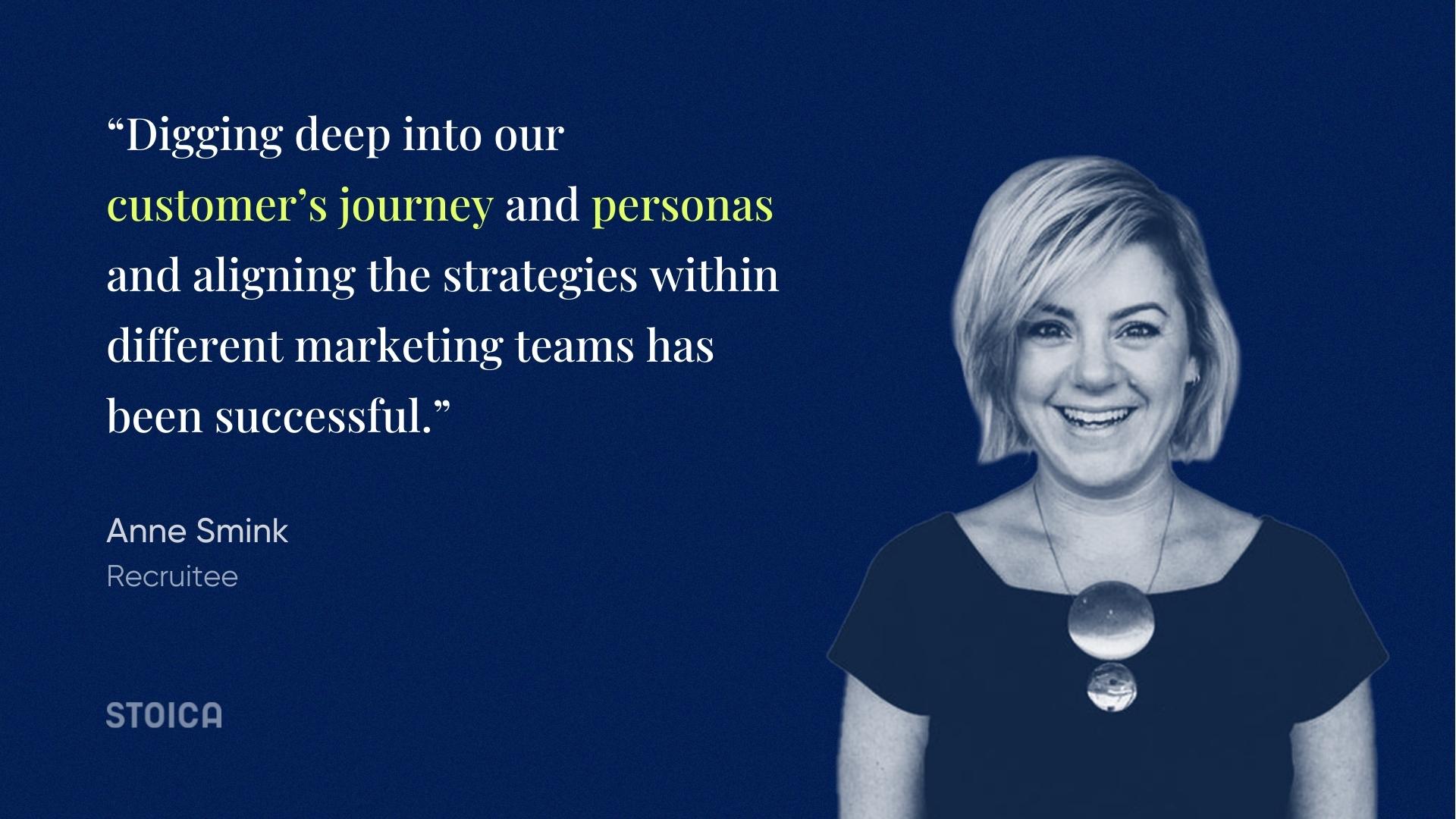
“What has brought us the most success is really digging deep into our customer’s journey and the personas, and aligning the strategies within different marketing teams. The journey is so complicated in B2B, and for a lot of touchpoints, it’s a dark funnel. So we’ve been taking the time to understand our personas, know what keeps them awake at night, what they come to work for, what their journey really looks like. As we are scaling rapidly and so does the marketing team it has been equally important to break the siloes and make sure we work towards the same goals.” – Anne Smink, Recruitee
From our own experience at STOICA, what we worked on the most in 2021 was helping clients consolidate their website as an educational content hub (building pillar pages around key topics, building on-demand video libraries), improve their website for search engines (optimize site speed, ensure website’s technical health) and improve the users’ experience on site.
Increasing our team members’ visibility on LinkedIn and developing our strategic narrative were also in focus for us last year.
Don’t have time to read now? Download and read later.
Looking forward: what are B2B marketing experts focusing on in 2022?
In today’s world of (close to) infinite supply in which the customers have the upper hand, the companies that will manage to stand out and grow are the ones that concentrate on the long-term game. They focus on building for the long run, creating ever green marketing assets, educating and advising even if that takes more time. And shy away from isolated marketing tactics that make an impact on short term only.
#1 Creating long-term assets
Short-term tactics and marketing plays are not a winning strategy in a B2B environment, as confirmed by the experts we consulted. But going back to the roots, understanding clients’ needs and how they discover and buy products and services, and investing in creating assets for the long run are.
Content
Content is without a doubt one of the best long-term investments B2B tech companies can make and it’s one key focus area our contributors mentioned.
What we’re also noticing is that some companies are going beyond using content as an inbound play (create content to attract traffic and then present content offers). They are evolving into media companies, aiming to become the go-to source of relevant information around specific topics.
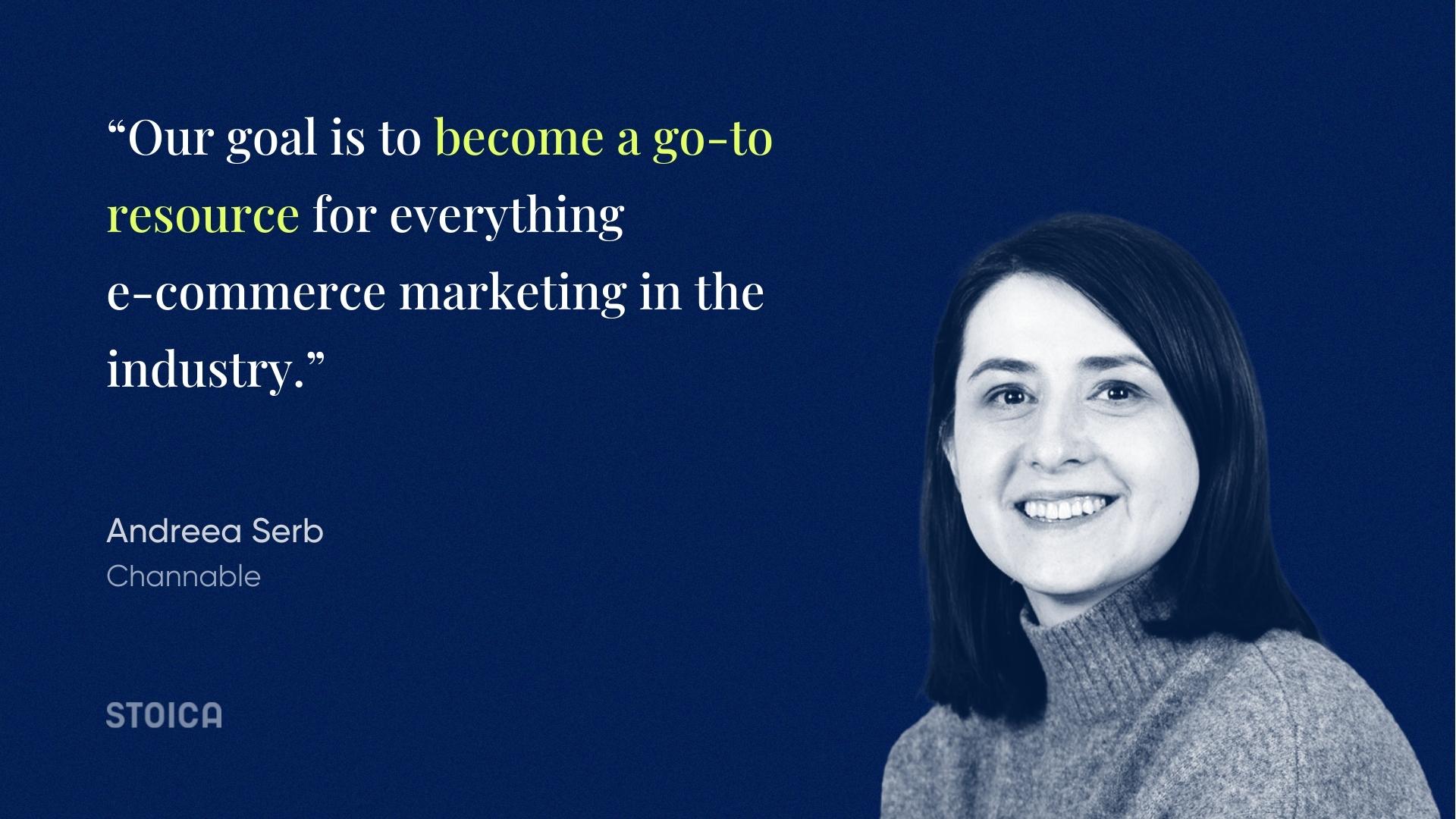
“Our goal is to become a go-to resource for everything e-commerce marketing in the industry. So I’ll be focusing on refining, creating, amplifying, and repackaging content for our owned media to get there. Think of a combination of SEO, thought leadership, and data storytelling to attract, inspire, and convert strangers into customers.” – Andreea Serb, Channable
And the key to creating inspiring and exciting content? Ground your content
strategy in customer research and try to educate them on their (latent)
problems & challenges. Share your knowledge and point of view from a helping
perspective, rather than obsessing over immediate ROI.
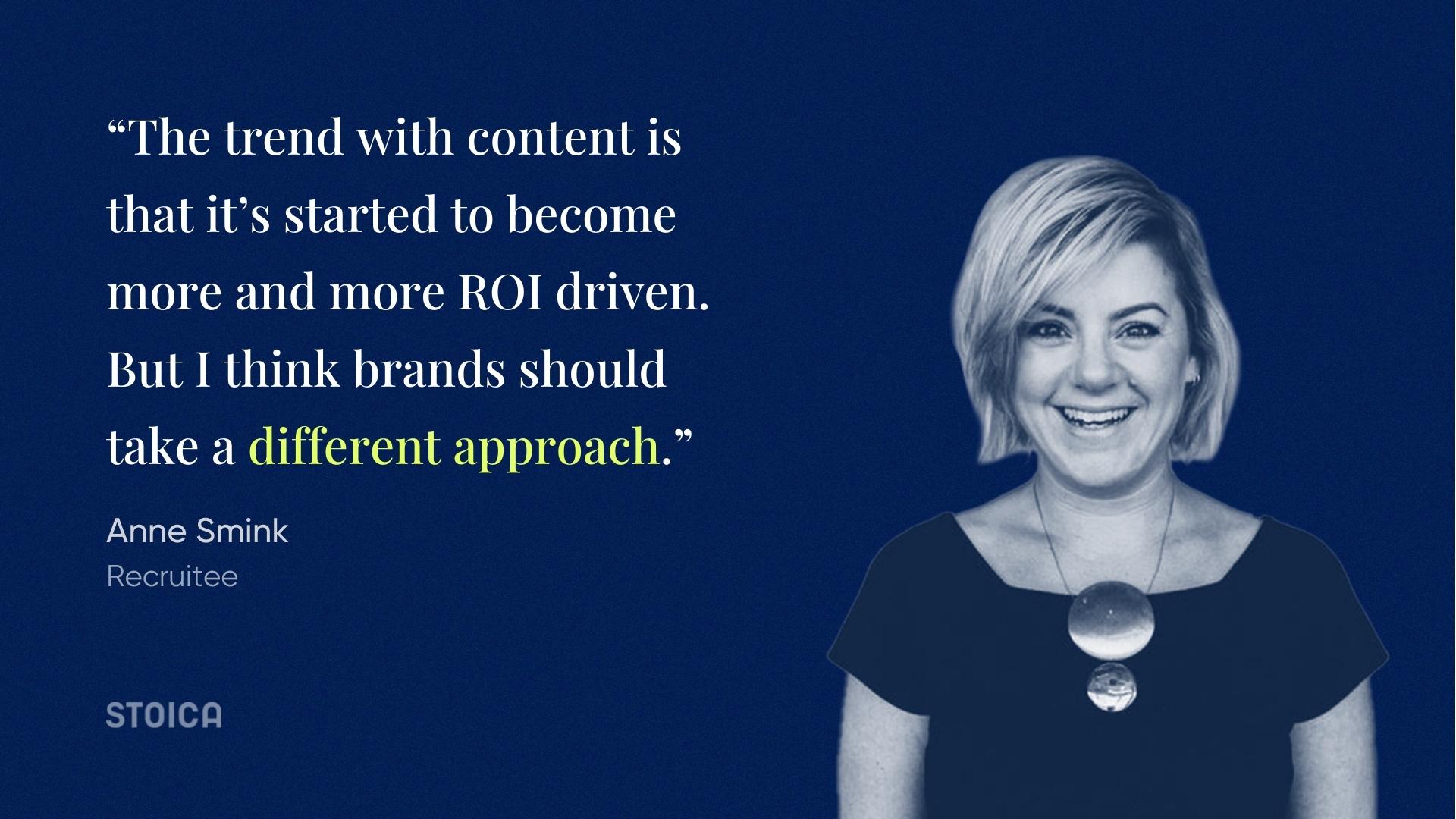
“The trend with content is that it’s started to become more and more ROI driven. But I think brands should take a different approach, create that original and inspiring content that helps them stand out and show they know their customers really well. So in terms of content strategy, we’ll focus on customer research, not only on revenue and ROI, test out hypotheses, optimize our content strategy for dark social.” – Anne Smink, Recruitee
Anna-Theresia Bohn explains their focus on product storytelling as part of their content strategy.
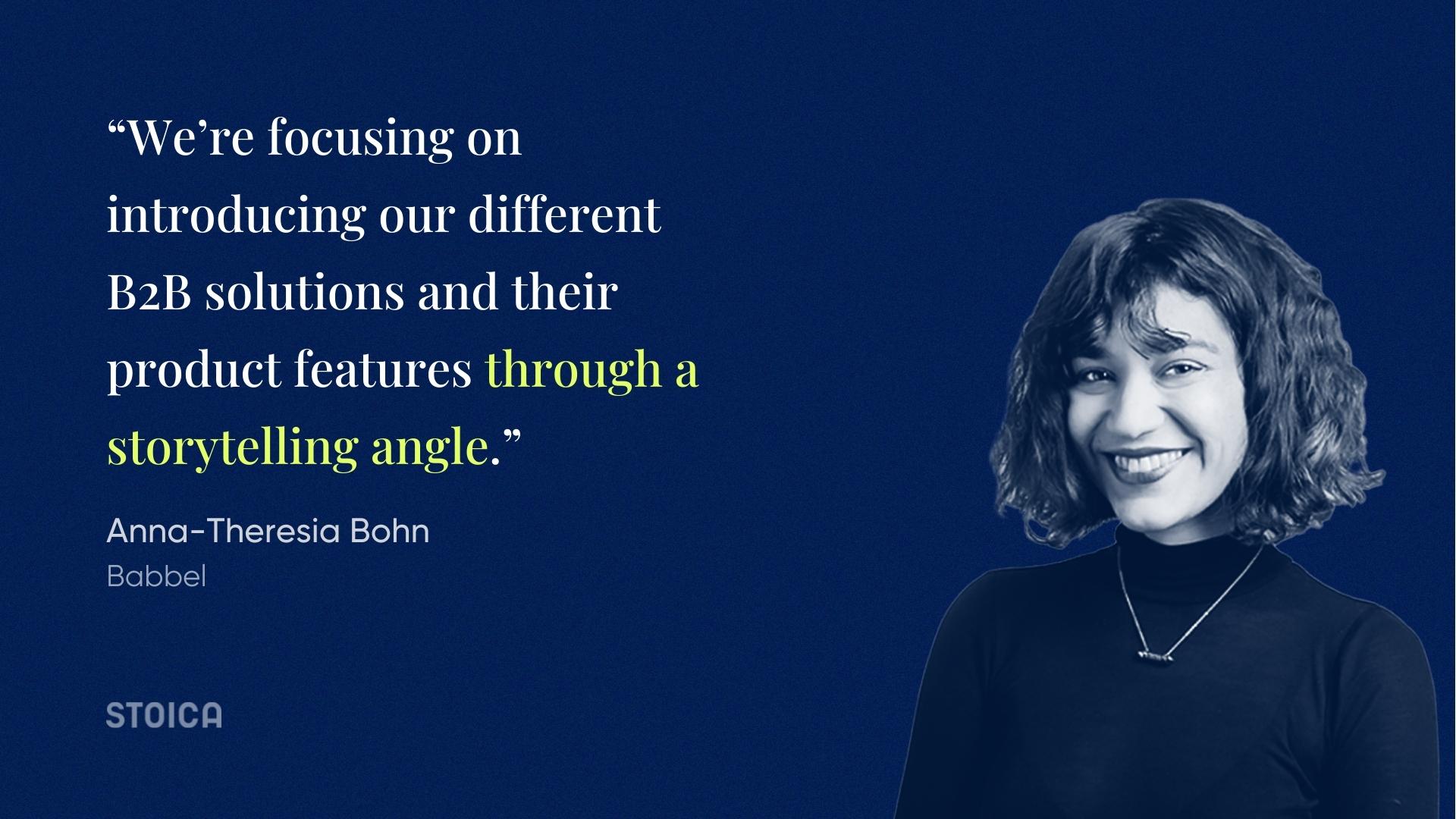
“We’re focusing on introducing our different B2B solutions and their product features through a storytelling angle. How a certain product feature exists to solve a common problem that our prospects experience.” – Anna-Theresia Bohn, Babbel
“At my current company, Adnovum, we’re working hard on improving our content strategy in terms of production, repurposing, and distribution. And ideally, I’d love to launch our podcast.” – Sara Lattanzio, B2B marketing strategist & content creator
“In 2022 we’ll focus on testing content and formats and how they can resonate best with our target audience. Think of A/B testing experiments tailored to lead generation, content creation.” – Jonathan Bluemel, IDnow
Increasing Brand Awareness
2022 is likely to be the year that we see companies invest in growing individual employees’ profiles just as much as the company’s brand.
Having a visible founder or senior leader in your team is an incredible asset, as they can educate potential clients about problems you solve long before they realize they have it.
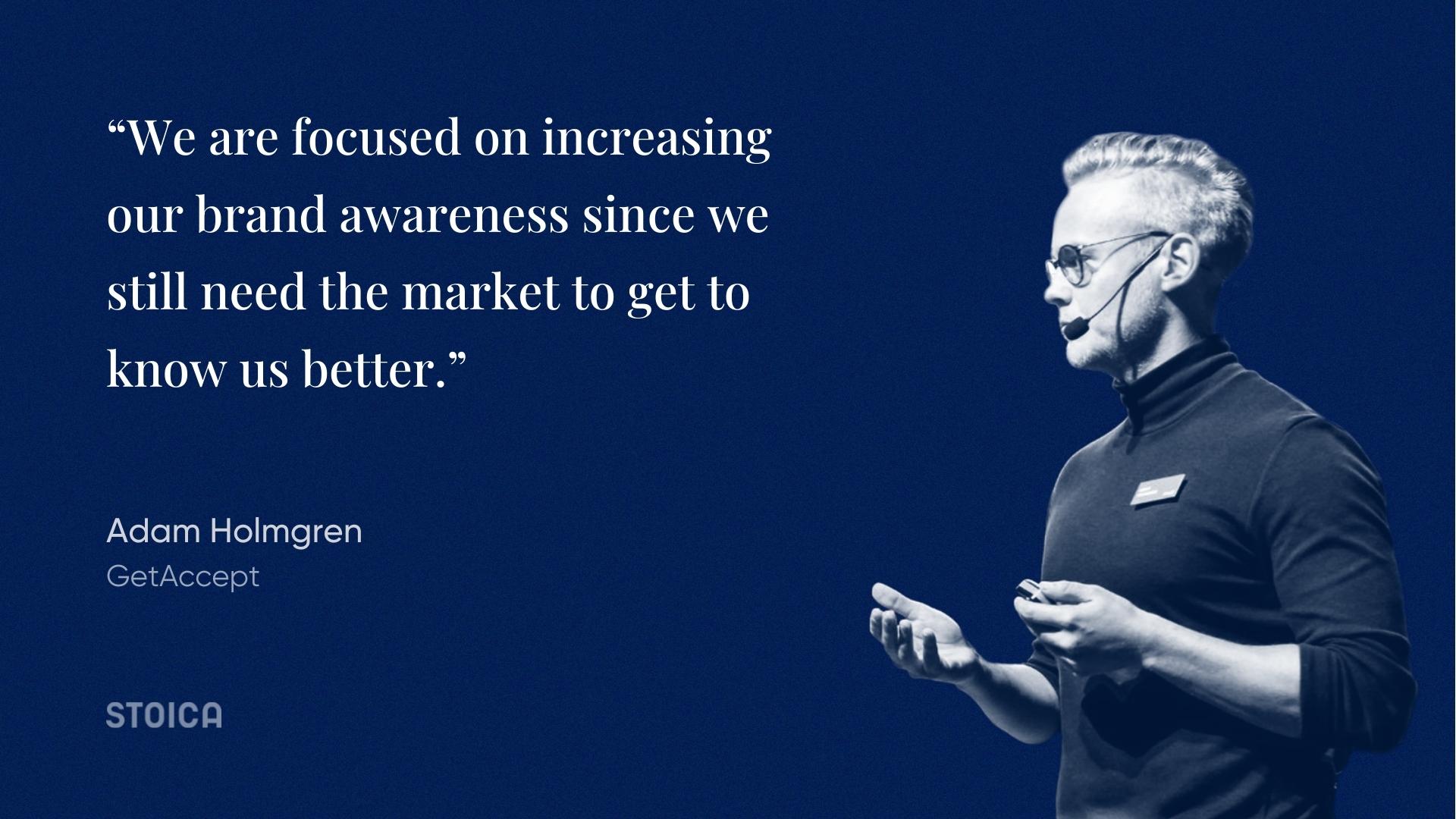
Companies such as Lemlist, Refine Labs or Databox have been growing significantly and they get discovered many times through their CEO’s or CMO’s content and LinkedIn profiles.
“This year, I want to start social selling and personal branding programs for our leadership team.” – Sara Lattanzio, B2B marketing strategist & content creator
“We are focused on increasing our brand awareness through different channels (communities, events, ads) since we still need the market to get to know us better.” – Adam Holmgren, GetAccept
Websites as the key conversion point in the buyers’ journey
Gartner CMO Leadership Vision 2022 report reveals that the percentage of procurement through websites is expected to grow to 37% by 2023. That is a 12 point jump from 2021.
So there is no surprise that in 2022 one of the core investment areas will be improving users’ experience on-site, especially across mobile devices. With more than half of annual online website traffic coming from mobile, companies want to make sure they provide potential clients with the best mobile experience possible.
According to HubSpot data, 33% of global marketers invest in mobile web design, and 64% of SEO marketers call mobile optimization an effective investment.
#2 ABM campaigns and demand generation
ABM has been gaining traction and is no longer an emerging trend but a tactic adopted more widely. HubSpot survey reveals that in 2021, 62% of marketers leveraged account-based marketing, and this year 33% of marketers who haven’t used it plan to invest in it for the first time.
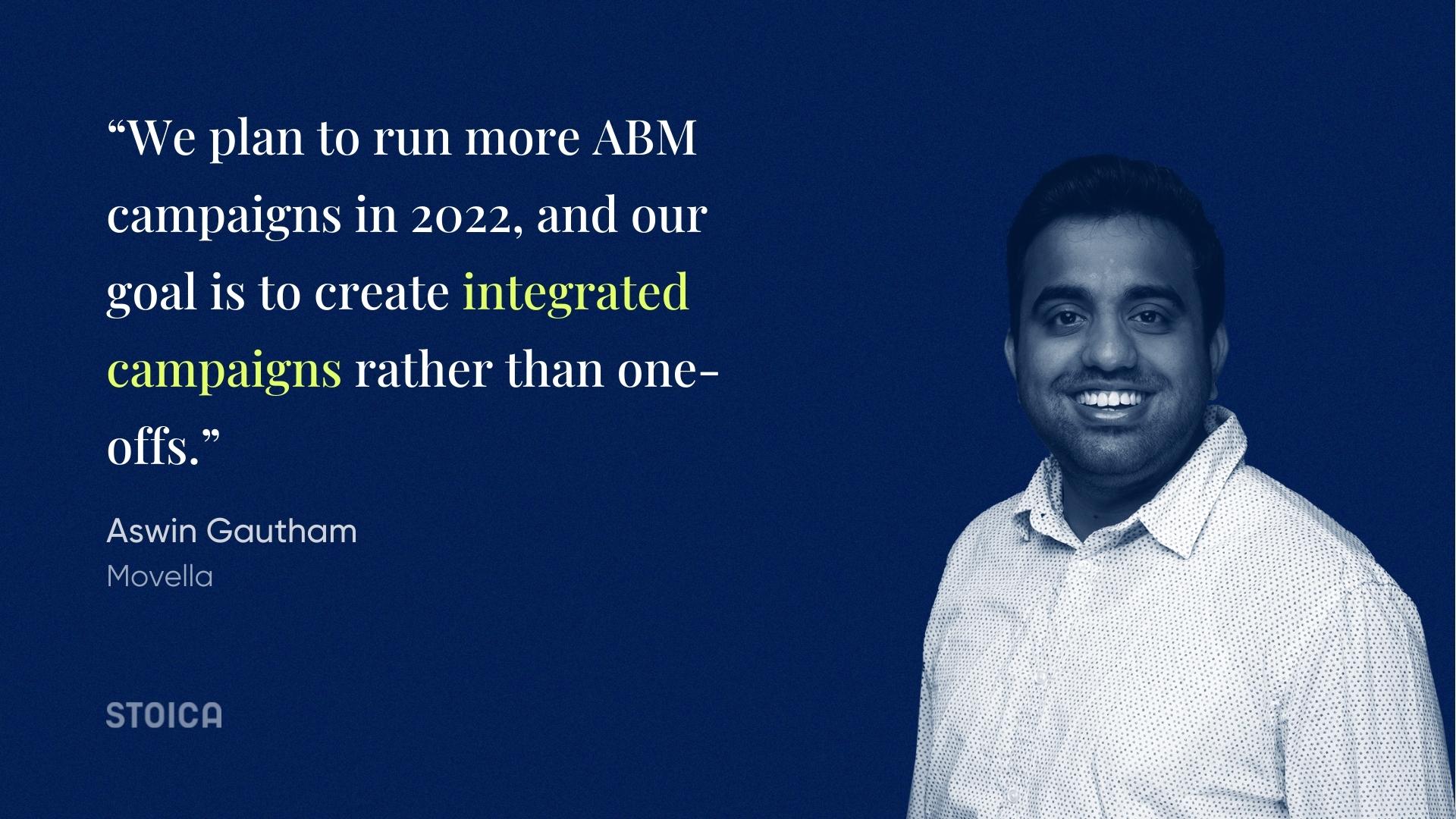
“We will focus more on the demand generation and ABM side of things, as we are looking to have a more predictable sales and marketing operation. We’re now taking the steps to transform the more “traditional” inbound funnel that has been working really well at Recruitee. We take our hyper-localized approach even further in 2022. Together with the sales & customer success team we continuously deepen and broaden our collaboration.” – Anne Smink, Recruitee
“ABM is going to have a much bigger role within our company, a perfect way to align targets with sales.” – Adam Holmgren, GetAccept
“We plan to run more ABM campaigns in 2022, and our goal is to create integrated campaigns rather than one-offs.” – Aswin Gautham, Movella
“The current strategy is to design and deploy integrated marketing campaigns on multiple channels, to target very specific audiences in a few industries across the globe. Each campaign involves a consistent effort to develop digital content to feed the funnels, from whitepapers and interactive infographics to product videos and relevant video-customer testimonials.” – Daniel Ionescu, DRUID
#3 Putting the customer in the center and interacting with them on their own terms
The marketing experts we talked to mentioned actively listening to customers’ feedback and responding to their needs, in whatever shape or form, as a top priority in 2022.
Catering to their needs can mean creating and managing a dedicated community, making product or services information available in the form potential clients require it, when they require it, offering both self-service experiences and human interactions, and more.
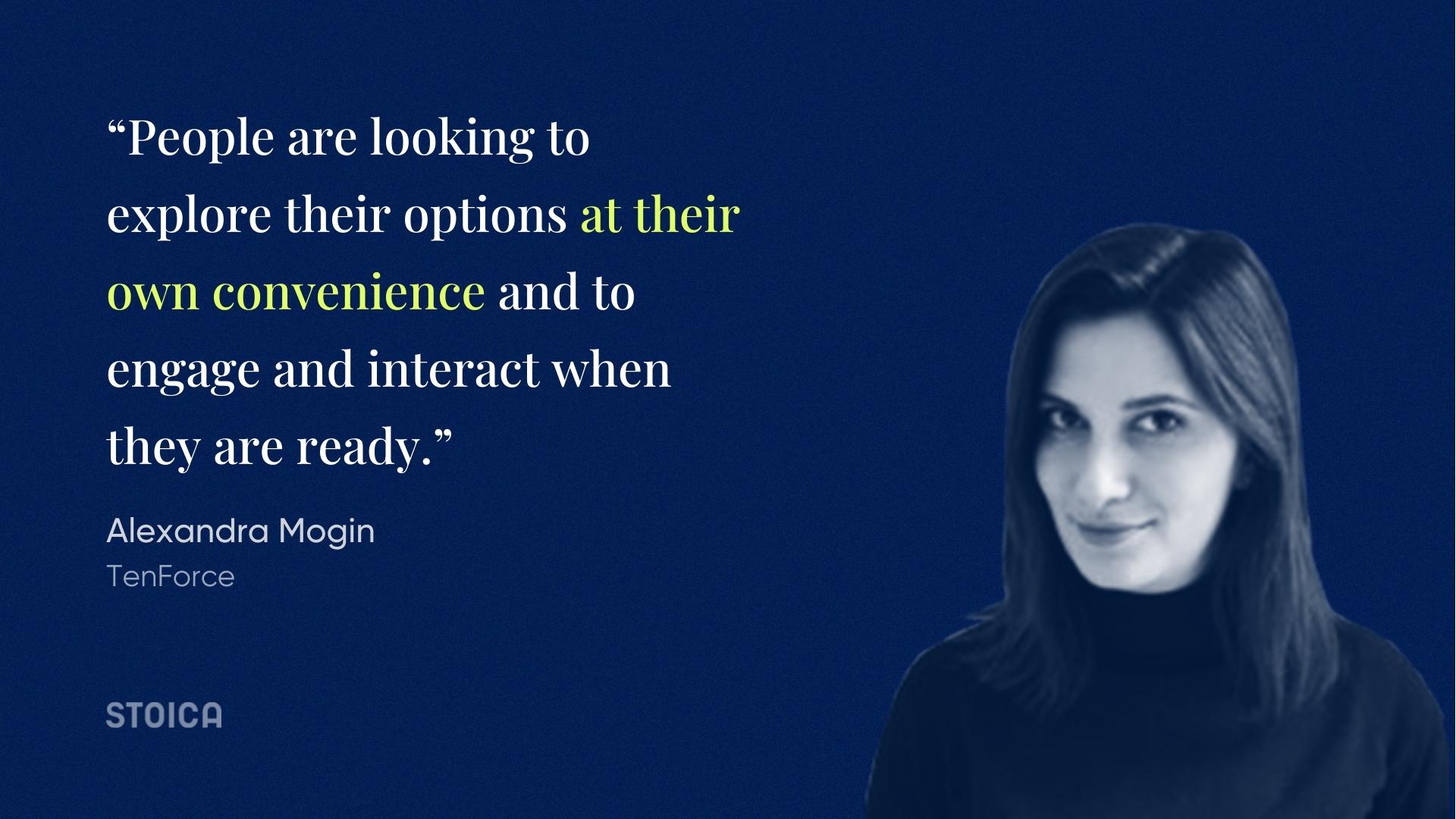
“Close client relationships have always been important at CELUS and always will be, and now more than ever it’s time to actively bring people together and provide them with a sense of belonging and impact. So this year we’ll open a new playground for electronics experts, we’ll take care of people’s need to exchange ideas and to solve problems on another level. This will be a very inclusive approach, where we will invite people to develop, contribute and improve things and make them part of the CELUS success story.” – Nicole Lontzek, CELUS
“People are looking to explore their options at their own convenience and to engage and interact when they are ready. That implies allowing your prospects or customers to watch a demo, instead of attending it live. Allow them to watch a recording of your event, while still finding ways to interact and engage. Take a big online event and share it in bite-sized pieces, interact and take questions long after the event is over and the speakers went home, share recorded product demos, case studies etc.” – Alexandra Mogin, TenForce
“Knowing your customers is a journey, not a set-and-forget project. So this year we’ll continue to bring more actionable research about our customers, prospects, and markets. Based on that research we run experiments with our growth, SEO, and MarOps teams to continuously iterate and keep growing. We invest in community building, more original content and a voice of the customer program for example.” – Anne Smink, Recruitee
#4 Leveraging industry influencers and developing relationships with subject matter experts
Leveraging relationships with recognized voices in their respective industries is a top priority for some of our contributors.
“We are planning very close journeys together with subject matter experts from Conversational AI space to reach the expected level of confidence and trust of end consumers regarding our vision and technological capabilities.” – Daniel Ionescu, DRUID
#5 Co-marketing
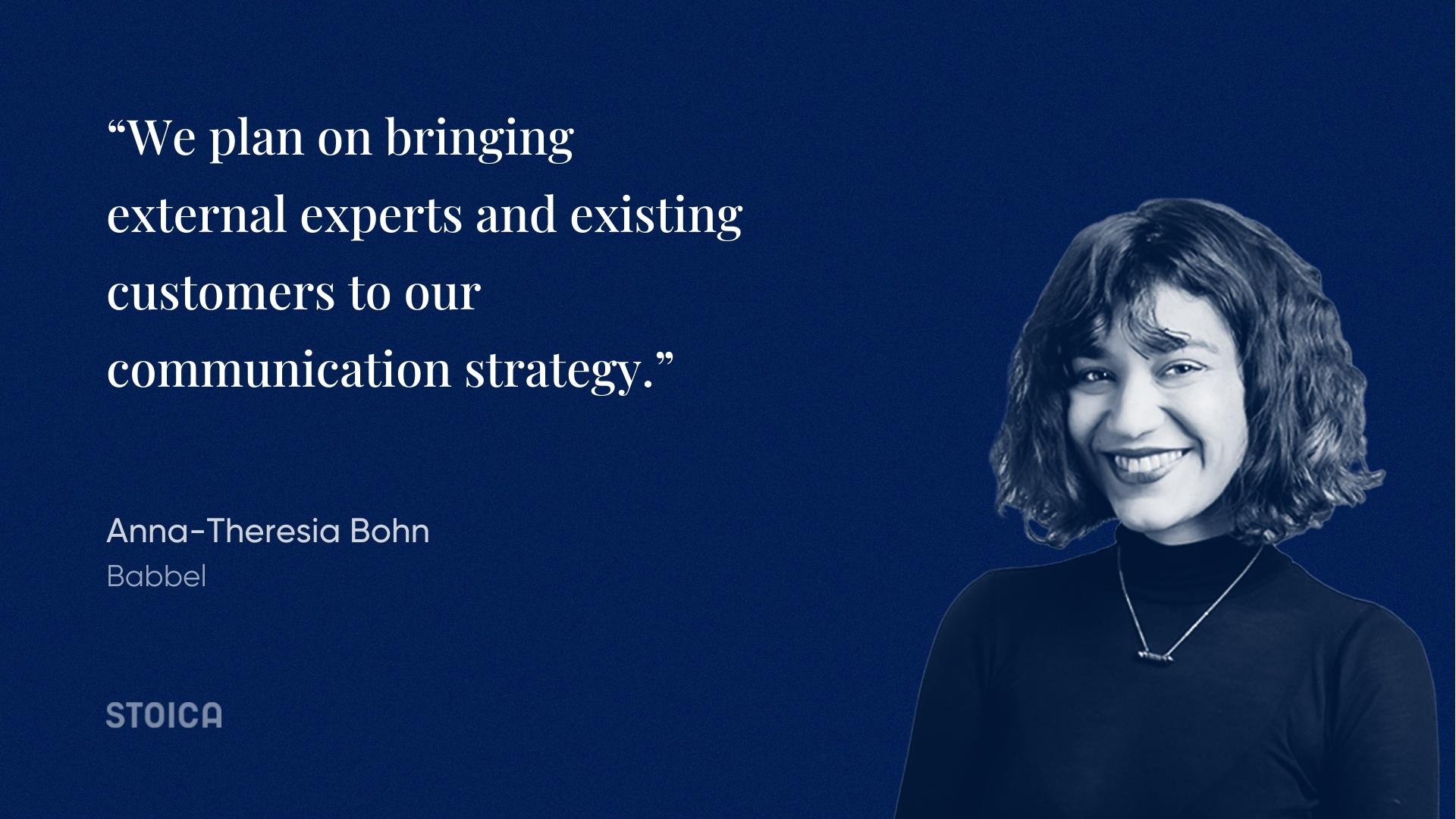
“An important element for 2022 will be co-selling and co-marketing programs with the partners network, having now onboarded more than 120 partners from all regions. The main tactic is to bring value to our partners through the opportunities we generate directly or together with them.” – Daniel Ionescu, DRUID
“If we have a large contact database, other brands have one as well. It will be important to try to cross these databases with brands that share our vision. It’s a win-win situation.” – Marilyne Dupuy, PickYourSkills
“We plan on bringing external experts and existing customers to our communication strategy.“ – Anna-Theresia Bohn, Babbel
#6 Live events
What virtual events couldn’t replicate were the networking and human interactions that come with live events. So while webinars and online events will likely stick around, some of our contributors mentioned investing in live events as soon as the context will allow.
“We will witness a boom when it comes to face-to-face events. As long as the safety rules will allow, people are eager to meet again in person. So, once the sanitary crisis settles, conferences, trade fairs will see a re-birth. And that’s where we’ll direct a big part of our attention, especially in the second part of the year.” – Alexandra Mogin, TenForce
Recommendations for 2022
How should you approach your marketing strategy in 2022, so that you can leverage the right trends and insights surfaced in the eBook?
#1 Focus on revenue
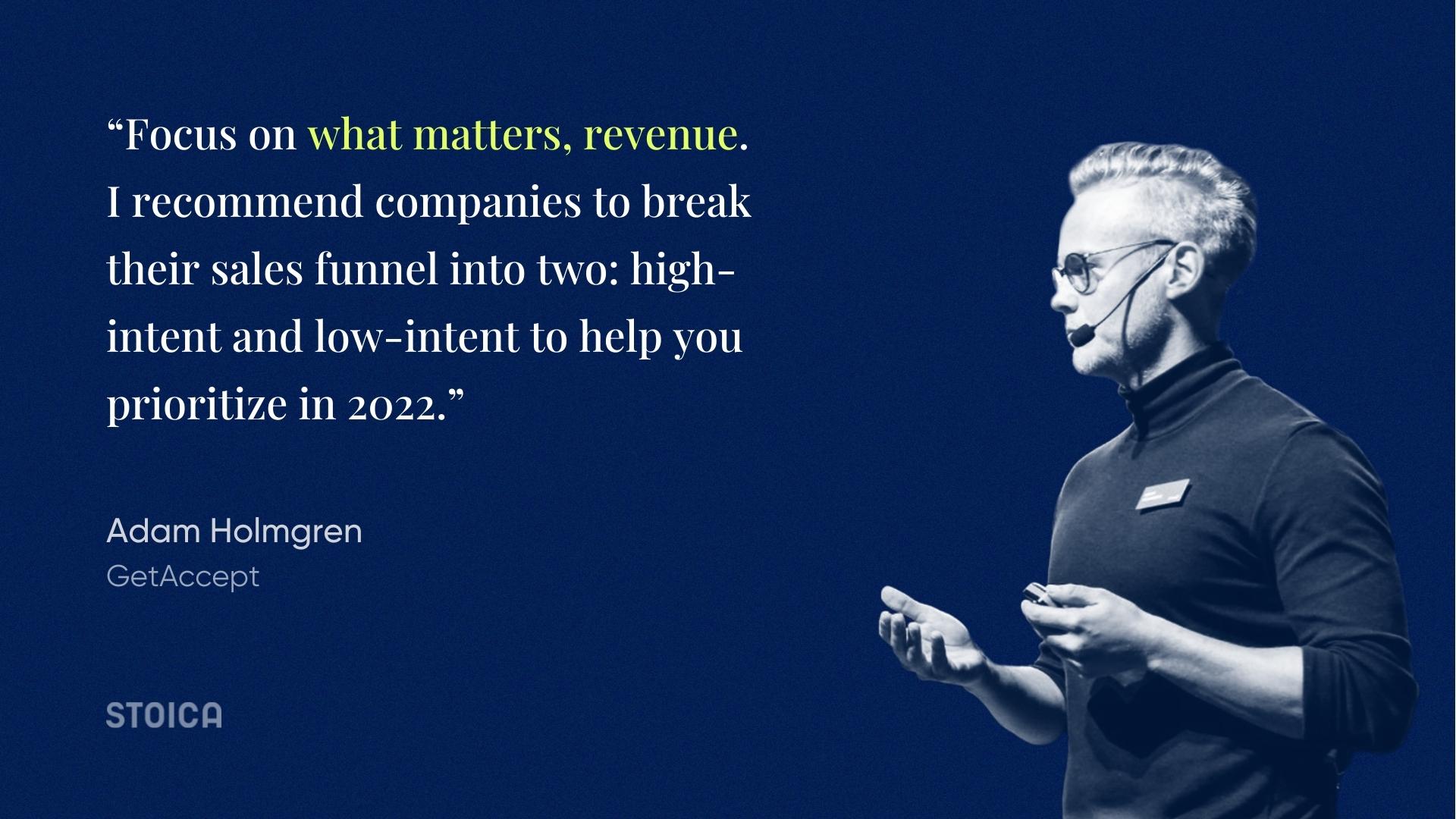
“Focus on what matters, revenue. I recommend companies to break their sales funnel into two: high-intent and low-intent, where the former refers to demo or contact request and the latter to free trials and similar. Then you will see that most of your revenue is acquired within your high-intent funnel and most of your MQLs are acquired within your low-intent funnel, a clear conflict of interest that will help you prioritize in 2022.” – Adam Holmgren, GetAccept
“I encourage marketers to try bringing the whole organization together to focus on a single goal of driving revenue.” – Aswin Gautham, Movella
#2 Be flexible with your plans
“Be flexible with your plannings. Covid is still around and having a plan B is not the worst thing to do.” – Nicole Lontzek, CELUS
“I don’t think we can talk about a 2022 budget execution with Q4 in line with the initial planning. So be flexible with the marketing budget, meaning you might need to have as many iterations with stakeholders as possible, on each budget line, allowing for on-the-go adjustments based on the ever-changing demands from sales team or customers.” – Daniel Ionescu, DRUID
#3 Be customer-centric

“One thing I would advise you is to get in touch with your best customers and ask them what they are burning for in terms of learning, in terms of optimization and create an event or a marketing piece out of this. Most of the time they can tell you exactly what they need if you ask carefully and stay persistent.” – Nicole Lontzek, CELUS
“It’s a new year for you as well as for your audience. Invest in understanding what this year’s challenges are for decision-makers in your target group, and activate your Content Marketing team to translate these insights into compelling stories.” – Anna-Theresia Bohn, Babbel
“Allow your prospects to build their own buyer journey. B2B buyers are smart and know what they want. Make it easy for them to get it. Invest in building domain expertise and knowledge-sharing.“ – Alexandra Mogin, TenForce
“Get inspiration from B2C best practices in terms of creativity, copy, and user-centricity rather than from other B2Bs or from your competitors.” – Sara Lattanzio, B2B marketing strategist & content creator
“I encourage you to have a customer-centric approach, which involves developing laser-focus marketing and sales strategies to understand new needs, then build and deploy extremely fast solutions on specific use cases. In DRUID, once a customer identifies a potential for automation in one specific area, the marketing team must immediately extract the customer’s need, the benefits sought, the impact pursued. Then, a whole process of developing marketing collaterals can help either to expand the adoption of our technology in other countries or to pack and sell the solution to other customers.” – Daniel Ionescu, DRUID
#4 Execute consistently and work as a team
“We’re all busy at the beginning of the year with elaborate plans but we often overlook two important aspects that can make us more successful: focus and consistency. Choosing a couple of key areas to focus our efforts on and always showing up to execute on them is by far more effective than trying to identify the latest trend or covering multiple channels at the same time.” – Andreea Serb, Channable
“Involve everyone in your team at an early stage when conceptualizing a project. Say you discover you have a shortage of content in a certain customer journey phase: then form a squad with your SEO, growth, product marketing, MarOps and creative people to align on what you’ll do and gather ideas. Rather than brainstorm with the content people
and then hand over assignments to other team members. You’ll be amazed by how creative your content turns out.” – Anne Smink, Recruitee
#5 Test as much as you can
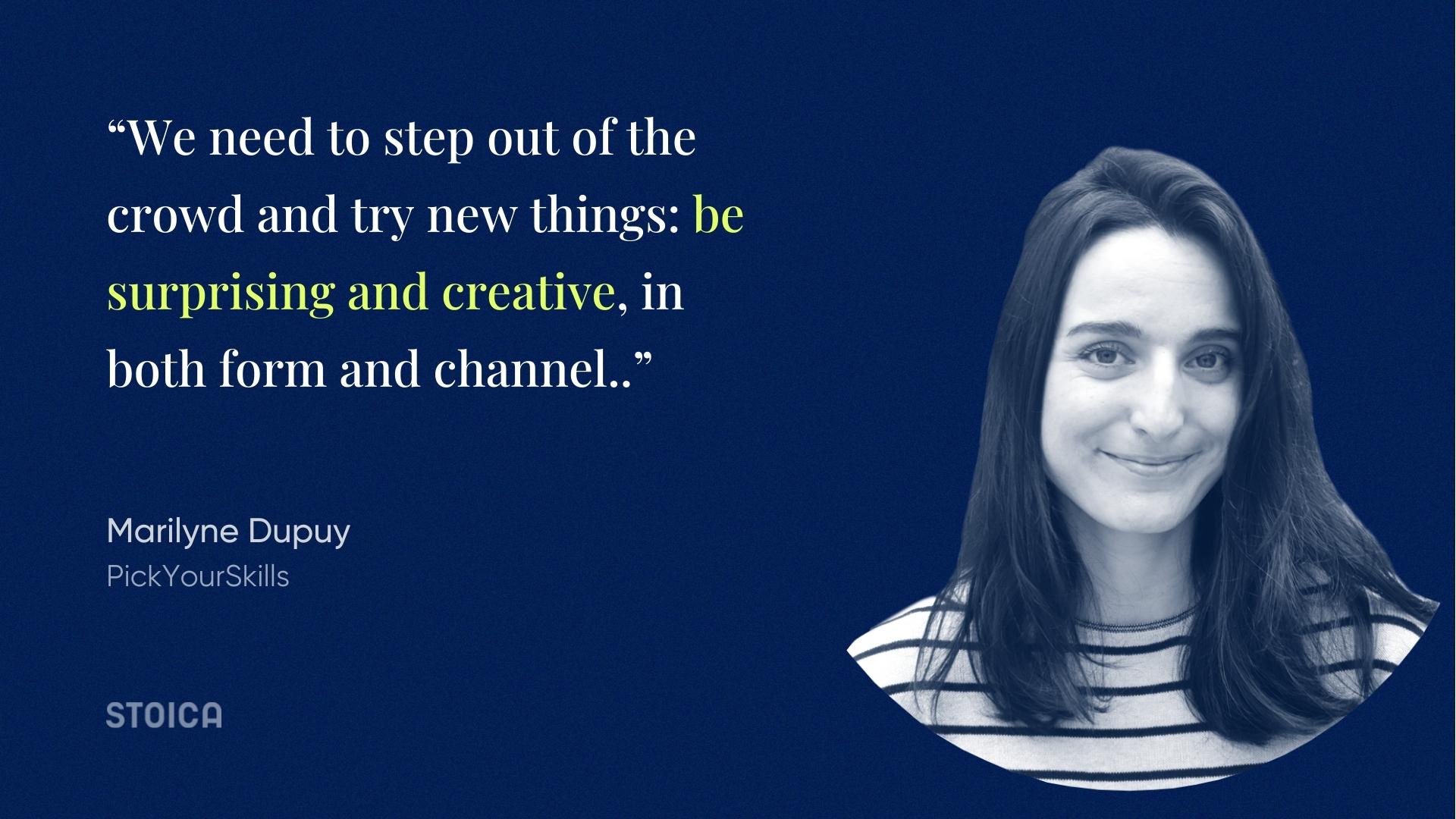
“Deep dive in your 2021’s data and try new things: if it works, iterate, and if it fails, try something else. We need to step out of the crowd and try new things: be surprising and creative, in both form and channel.” – Marilyne Dupuy, PickYourSkills
“Test, test, test. Don’t follow the often opinionated (internal biases) of how marketing campaigns and their contents should be like. Try extensive testing to understand your target audience, their preference, the right staging of content, also from a UX and design perspective.” – Jonathan Bluemel, IDnow
Summing up
If we were to distill all the valuable insights and experiences shared by our contributors, we could say that winning at marketing in 2022 is about playing the long-term game.
It’s about putting your customers in the center of your strategy, listening to their evolving needs, deploying solutions to cater to those needs, and empowering them to interact and buy in a way that works for them.
Create long-term assets that make your current and future clients’ lives better: communities around the same interest, content hubs and educational resources, and a flawless website experience.
A strong personal brand is just as important as your company’s brand, so identify your most vocal advocates and empower them to become visible in the right channels.
Work with your ecosystem to build and increase trust: your current clients, partners, and industry influencers.
All while staying consistent in your actions and keeping in mind that your north star should be revenue contribution over any vanity metric.
